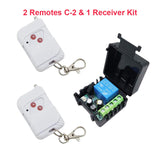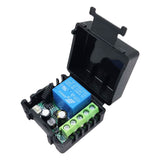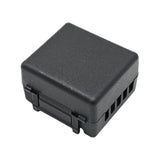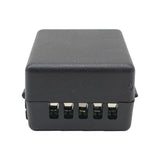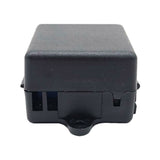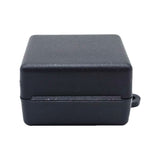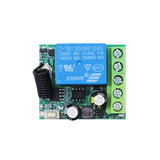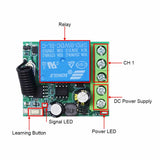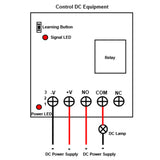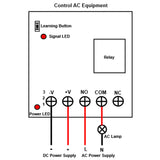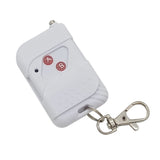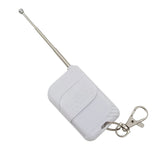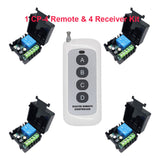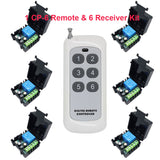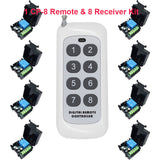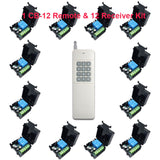Package Include:
1 x Receiver: S1UD2-DC
2 x Transmitter: C-1/C-2
1 x User manual
Introduction:
This receiver has an adjustable time delay function. You can set its relay to turn off automatically after a delay time of 5, 10, 15 or 20 seconds. When you set the delay time, the devices connected to the receiver will automatically stop after the delay time.
This receiver can be used in one-transmitter-many-receivers system. For example, you can use a 1 button transmitter to control 1 receiver, or use a 2 buttons transmitter to control 2 receivers, or use a 4 buttons transmitter to control 4 receivers, or use a 6 buttons transmitter to control 6 receivers, or use an 8 buttons transmitter to control 8 receivers, or use a 12 buttons transmitter to control 12 receivers, or use a 15 buttons transmitter to control 15 receivers.
Application:
This receiver is an electric device with dry relay output, it and the transmitter form a wireless remote-control system. This system may be used in all types of industry automation, agriculture, business, home, factory, house, farm, garage, vehicle, ship, aerial vehicle, etc. It can remote control different AC or DC equipment on land, water, and air, such as lights, doors, windows, lamps, sockets, locks, sirens, outlets, heaters, motors, fans, winches, curtains, blinds, linear actuators, electric solenoid valves, and security alarm systems. The applications are endless.
Feature:
Wireless control, easy to install.
DC 5~28V operating voltage range.
Relay Output: This receiver has dry relay output; it can be used to operate both DC and AC equipment. The output terminals are NO / NC (normally open / normally closed), serving as a switch. That means you should also connect a separate power supply to equipment.
It can work at maximum current 10A.
With time delay function, you set its relay to turn off automatically after a delay time of 5, 10, 15 or 20 seconds.
The transmitter / remote can control the receiver from any place within a reliable working distance.
Wireless RF signal from the transmitter can pass through walls, floors, doors, or windows, but it will lose some operating range.
The receiver can store up to 20 transmitters with different codes.
The receiver can only be triggered by paired transmitters.
Two or more receivers may be used in the same area.
One or more transmitters / remotes can control one or several receivers simultaneously.
You can use one transmitter to control multiple receivers, and each transmitter button controls one receiver. For example, you can use a 2 buttons transmitter to control 2 receivers, or use a 4 buttons transmitter to control 4 receivers, or use a 12 buttons transmitter to control 12 receivers, etc.
Receiver Parameters:
Model: S1UD2-DC
Operating Voltage: DC 5~28V
Working Frequency: 433 MHz
Quiescent Current: <5mA
Channel: 1 CH
Output Type: Relay Output (With Normally Open and Normally Closed Terminals)
Delay Time: 5, 10, 15 or 20 seconds selectable
Maximum Load Voltage of Relay: 240VAC or 28VDC
Maximum Load Current of Relay: 10A
Suitable Wires for Connecting Terminals: 22-14 AWG
4 Selectable Working Modes: Self-locking, Momentary, Interlocking, Time Delay
Receiver Sensitivity: >97dbm
Shell Material: ABS plastic shell
Operating Temperature: -20 °C ~ +70 °C
PCB size: 35 x 30 x 15 mm (1.4 x 1.2 x 0.6 inches)
Case size: 41 x 40 x 26 mm (1.6 x 1.6 x 1.0 inches)
Transmitter Parameters:
Model: 0021000 (C-1) / 0021001 (C-2)
Channel/Button: 1 (C-1) / 2 (C-2)
Button Symbol: No symbol (C-1) / A, B (C-2)
Operating Voltage: 12V (1 x 23A -12V battery, can be used for 12 months)
Operating Current: 6mA
Operating Frequency: 433.92Mhz
Encoding Chip: PT2262/ PT2264/ SC2262
Encoding Type: Fixed code by soldering, up to 6561 codes.
Transmitting Distance: 100m / 300ft (theoretically)
Modulation Mode: ASK
Unit Size: 58 x 39 x 16 mm
Matching Transmitters:
The receiver can work with different transmitters, such as model C-1 / C-2 / C-4 (100M), CWB-1 / CWB-2 / CWB-4 (50M, waterproof), CP-1 / CP-2 / CP-4 / CP-6 / CP-8 / CP-15 (500M), and CB-1 / CB-2 / CB-4 / CB-6 / CB-8 / CB-12 (1000M) etc.
Working Range:
This receiver and different transmitters form a complete set, which can achieve different working distances. For example, when it and the transmitter C-1 or C-2 form a complete set, the maximum working distance may reach 100 feet or 30 meters in an open area. When it and the transmitter CB-1 or CB-2 form a complete set, the maximum working distance may reach 1000 feet or 300 meters in an open area.
The maximum working distance is based on theoretical data without obstacles and any RF interference. In practice, it will be hindered by trees, walls, or other construction, and will be interfered with by other wireless signals. Therefore, the actual working distance may not reach this maximum distance.
The receiver equipped with an external antenna has a larger working range than the receiver equipped with an internal antenna.
If you need a longer working distance, you can replace the antenna on the receiver, or use an RF signal repeater, or use a powerful transmitter, such as a CB-1 / CB-2 transmitter.
Usage:
The receiver can be used to control both 0~28VDC and 110~240VAC devices.
Notice: The receiver is relay output, not DC/AC power output. Initial state of relay output terminals: Terminals <COM> and <NO> are Normally Open; Terminals <COM> and <NC> are Normally Closed.
Wiring:
1) If you want to control a DC 12V lamp, do as follows:
1.1 Connect the positive pole of DC power supply to terminal <+V>, and connect the negative pole of DC power supply to terminal <-V>.
1.2 Connect terminal <NO> to the positive pole of DC power supply, connect terminal <COM> to the positive pole of DC lamp, and connect the negative pole of DC lamp to the negative pole of DC power supply.
2) If you want to control an AC 120V lamp, do as follows:
2.1 Connect the positive pole of DC power supply to terminal <+V>, and connect the negative pole of DC power supply to terminal <-V>.
2.2 Connect terminal <NO> to the live wire of AC power supply, connect terminal <COM> to one side of AC lamp, and connect another side of AC lamp to the neutral wire of AC power supply.
Setting different working modes:
The receiver will be set in Self-locking mode before leaving the factory, if you want to use another mode, please follow the following steps. When switching working modes, you need to clear the transmitter code stored in the receiver first.
1) Setting Momentary mode and pairing the transmitter:
1.1 Press the learning button once, the signal LED on the receiver flashes once and then stays on, it means the receiver enters the learning state.
1.2 Press the button you want to use on the transmitter, if the signal LED flashes 3 times, it means this button pairing is successful.
The operation of Momentary mode with the transmitter C-1:
Press and hold the button on the transmitter: The relay in the receiver is activated, and the connected lamp is turned on.
Release the button: The relay is deactivated, and the connected lamp is turned off.
2) Setting Self-locking mode and pairing the transmitter:
2.1 Press the learning button twice, the signal LED on the receiver flashes twice and then stays on, it means the receiver enters the learning state.
2.2 Press the button you want to use on the transmitter, if the signal LED flashes 3 times, it means this button pairing is successful.
The operation of Self-locking mode with the transmitter C-1:
Press the button on the transmitter: The relay in the receiver is activated, and the connected lamp is turned on.
Press the button again: The relay is deactivated, and the connected lamp is turned off.
3) Setting Interlocking mode and pairing the transmitter:
3.1 Press the learning button 3 times, the signal LED on the receiver flashes 3 times and then stays on, it means the receiver enters the learning state.
3.2 Press the button you want to use on the transmitter, if the signal LED flashes 3 times, it means this button pairing is successful.
The operation of Interlocking mode with the transmitter C-2:
Press the button A on the transmitter: The relay in the receiver is activated, and the connected lamp is turned on.
Press the button B on the transmitter: The relay is deactivated, and the connected lamp is turned off.
4) Setting Time Delay mode and pairing the transmitter:
The receiver has 4 selectable delay times: 5, 10, 15 or 20 seconds.
5 seconds Time Delay mode:
Press the learning button 4 times, the signal LED on the receiver flashes 4 times and then stays on, it means the receiver enters the learning state.
Press the button you want to use on the transmitter, if the signal LED flashes 3 times, it means this button pairing is successful.
10 seconds Time Delay mode:
Press the learning button 5 times, the signal LED on the receiver flashes 5 times and then stays on, it means the receiver enters the learning state.
Press the button you want to use on the transmitter, if the signal LED flashes 3 times, it means this button pairing is successful.
15 seconds Time Delay mode:
Press the learning button 6 times, the signal LED on the receiver flashes 6 times and then stays on, it means the receiver enters the learning state.
Press the button you want to use on the transmitter, if the signal LED flashes 3 times, it means this button pairing is successful.
20 seconds Time Delay mode:
Press the learning button 7 times, the signal LED on the receiver flashes 7 times and then stays on, it means the receiver enters the learning state.
Press the button you want to use on the transmitter, if the signal LED flashes 3 times, it means this button pairing is successful.
The operation of Time Delay mode with the transmitter C-1:
Press the button on the transmitter once: The relay in the receiver is activated, and the connected lamp is turned on.
After the selected delay time, the relay is deactivated automatically, and the connected lamp is turned off.
Note 1: During the delay time, you can also press the learning button in the receiver to immediately turn off the relay.
Note 2: If you press the transmitter multiple times during the delay time, the delay time will be counted from the last operation of the transmitter.
How to delete all transmitters codes stored in the receiver:
We have paired the transmitter to the receiver, if you don’t want the receiver to work with the transmitter, you can delete all transmitters codes stored in the receiver.
Operation: Press and hold the learning button in the receiver for 6 seconds, until the signal LED flashes 3 times and then turns off, at this time release the learning button, this indicates that all stored codes have been successfully deleted.


















